


From the very
beginning, the Khalkis case struck a somber note. It began, as was peculiarly harmonious
in the light of what was to come, with the death of an old man. Georg Khalkis,
internationally famous art dealer and collector, died of heart failure. After his funeral,
his attorney found that the will was missing and immediately called in the district
attorney. |
| "The Greek Coffin Mystery is a lively and
well -constructed yarn containing unusual setting, ingenuity of plot, a surprise solution
and legitimate use of the analytical deductive method."
--
Herald
Tribune Books "All I do know is that he has long seemed to me one of the very best detective authors now writing, and that I always grab every new story of his that comes along." -- J.B. Priestley - Evening Standard "Had me baffled but fascinated."-- Franklin .P. Adams |
| Above: The first books published sometimes had identical front covers. The spine of the books/dust cover differ only in the publisher's logo. Top left to bottom right: Both dust cover and hardcover for Stokes, Grosset & Dunlap, International Readers League (hardcover only), Triangle Books, Triangle Books (blue), Center/Sun Dial Press Books (with 2 variations for the hard cover) and finally the dust cover for the Tower/ World Publishing edition. (Click on the covers to see the differences) * |
| The Saturday Review, "Thrillers" by William C.
Weber June 18, 1932 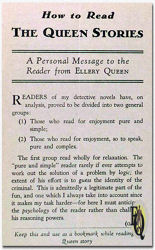 "Ellery Queen in 'The Greek Coffin Mystery' by throwing on all the lugs tries to be ultra intelligent and succeeds in becoming a bit soggy. Frankly, this impression is not given so much by the book itself as by a pompously ridiculous little leaflet inserted in each copy wherein the author (or authors) tells how the story should be studied, etc. Throw away this circular, destroy it utterly, and then you can enjoy the strange circumstances surrounding the death and burial of George Khalkis." |
| From the very first page, The
Greek Coffin Mystery sets a somber and intriguing tone. The case begins
with the death of Georg Khalkis, a wealthy, internationally renowned art
dealer. His passing seems straightforward - heart failure - until his will
mysteriously vanishes after the funeral. This puzzling development brings in
Inspector Richard Queen and his son, Ellery Queen, whose
keen analytical mind will soon be tested as never before. When the Queens are called in to assist, Ellery makes a daring suggestion: the one place yet unsearched for the missing will is the coffin itself. The decision to exhume Khalkis’s body unearths more than anyone expects — the coffin contains not one body, but two. This shocking discovery ignites a complex and twisting investigation that spirals into one of Ellery Queen’s most formidable and mind-bending cases. What follows is a detective story of rare depth and structure. Unlike conventional mysteries that build toward a single resolution, The Greek Coffin Mystery boldly offers four separate solutions, each culminating a distinct phase of the novel. These aren't arbitrary twists - they serve as an evolving framework that mirrors the very nature of scientific reasoning: observation, hypothesis, revision, and final synthesis. Michael E. Grost aptly compared Queen’s method to that of Newton building upon Kepler and Tycho Brahe - a layering of rational thought that leads, finally, to truth. The ingenuity of this structure elevates The Greek Coffin Mystery to a high point in detective fiction. The final solution is startling - so much so that some readers, like one reviewer in the Ramapo Valley Independent (June 24. 1932), felt tricked. Without spoiling the ending, it's fair to say that Ellery Queen plays a daring narrative card, challenging the reader's assumptions in the final chapters. Some felt this twist was unfair, even accusing Queen of betrayal. Others — including critics like Franklin P. Adams ("Had me baffled but fascinated") and J.B. Priestley, who praised Queen as “one of the very best detective authors now writing” - found it bold and brilliant. Structurally, this is the most confounding and intricately plotted of the early Queen novels. With more twists and turns than the Mississippi River, it remains my favorite alongside The Finishing Stroke. While the latter showcases a more emotionally mature Ellery, The Greek Coffin Mystery outpaces it in sheer narrative ingenuity. |
        |
|
Adding to its appeal is the symbolic
playfulness typical of Queen’s early work. Famously, the chapter titles in
this novel spell out the name of the book - The Greek Coffin Mystery
- a touch of cryptographic charm that underscores the authors' obsession
with literary form and detail. This book is a shining example of the
cousins' early urge for structural experimentation, serving as their only
novel to fully implement this acrostic device. In contrast to contemporaries like Anthony Berkeley, whose The Poisoned Chocolates Case (1929) is built around absurdist multi-solution scenarios that undermine the detective genre, Queen’s intent is just the opposite. The novel is derived from E.C. Bentley's 1 Trent's Last Case (1913) which has two solutions, and shows its detective failing to solve the mystery, with the true solution being only revealed by chance after the detective offers a false (if ingenious) explanation. Berkeley used this plot pattern repeatedly in his books, with numerous variations: both multiple solutions and failed detectives abound. Berkeley seems most interested in writing an anti-detective story, showing how each situation can be twisted to express a multitude of interpretations, mocking the idea of detective stories in general, and the ability to understand anything through reason. His solutions aren’t designed to mock logic but to explore how deeply reason can penetrate. The message is clear: reality is complex, but it can be understood through careful deduction. If the Queen novels sometimes show off, The Greek Coffin Mystery shows off with purpose. Its design is a tour de force - complex but not chaotic, startling yet justifiable. It reminds readers that American detective fiction could rival, and even surpass, its British counterparts in complexity and craftsmanship. Whether you love it or feel betrayed by its final gambit, this is a book that demands engagement. As Herald Tribune Books put it, the novel offers “unusual setting, ingenuity of plot, a surprise solution and legitimate use of the analytical deductive method.” And that may be the truest summary of all. |
|
1 E.C. Bentley was a British newspaperman. He only wrote four mystery books, but he was immensely influential and prestigious in his time. His reputation peaked around 1940 |
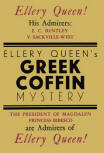 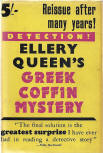    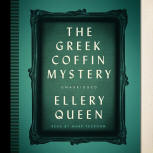  |
| Ramapo Valley Independent - "Cover to cover" June 24. 1932 "Ellery Queen who, by the way attended the big "Candida" opening in Nyack last week, was one of our favorite writers of detective stories until we read his latest book, "The Greek Coffin Mystery." In it he plays what we consider one of the lowest tricks that a mystery scrivener can put on his readers. We can't tell you what that trick is without giving away the solution of the story and, mad as we are at Ellery, we don't sink as low as that, and it isn't just because we couldn't solve the riddle that we're angry. Many times before we have been fooled by Master Queen's tangles. "The Roman Hat Mystery", "The Dutch Shoe mystery" are two of the best puzzlers in the business. And "The Greek Coffin Mystery" is excellent in its early stages. The beginning is particularly auspicious. A gentleman by the name of Khalkis - a wealthy Greek gentleman who is head of an internationally-famous art gallery - dies. With long faces, his friends, relatives, and business associates gather in his gloomy old house for the funeral. Khalkis is buried in the graveyard of the church next door (the scene is New York City) and the mourners go back to the house to read the will. But the will has disappeared from the wall safe where it was seen a few moments before the funeral! So the police come in and there is a search of several days for the will. High and low, it cannot be found. Ellery Queen, the master sleuth come into the case with his father, Inspector Richard Queen. It is decided to exhume the body of Khalkis and make sure that his death was a natural one. The ornate coffin is dug up and opened, and to the consternation of all, it now contains two bodies - that of Khalkis and another of an unknown man. This starts the case off in earnest, and the chase is thoroughly absorbing until the final chapters, when the above-mentioned trick is played at the expense of the reader. We don not propose to read any more of Queen's books if he is going to act like this. Probably in his next one he will make Ellery Queen himself the murderer. That would be no worse than the individual who is used in the present book." |
|
Elements for "The Game" According to JJMcC this case precedes the earlier publications and dates back to the years when Ellery was just graduated from college. There is a challenge to the reader included. |
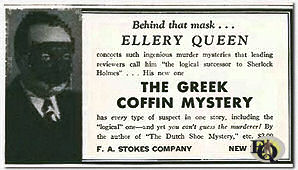 Above: Add in The New Yorker, April 23, 1932. "Behind that mask... Ellery Queen concocts such ingenious murder mysteries that leading reviewers call him "the logical successor to  Sherlock
Holmes"... His new one "The Greek Coffin Mystery" has every type of
suspect in one story, including the "logical" one - and yet you can't guess
the murderer! By the author of "The Dutch Shoe Mystery," etc. $2.00
F.A. Stokes Company New York" Sherlock
Holmes"... His new one "The Greek Coffin Mystery" has every type of
suspect in one story, including the "logical" one - and yet you can't guess
the murderer! By the author of "The Dutch Shoe Mystery," etc. $2.00
F.A. Stokes Company New York" |

|
The Greek Coffin
Mystery Translations: |
|
Other articles on this book (1) The Green Capsule Noah Stewart (Jan 2018) (2) Mysteries Ahoy! Aiden Brack (Feb 2018) (3) Reading Ellery Queen Jon Mathewson (Jun 2013) (4) Elleryana Ho-Ling (May 12. 2013) (5) The Grandest Game in the World Nick Fuller (Dec 20. 2017) |
|
*
Interested readers should know
that the icons/covers
of books, used throughout the
website have extra
descriptions/information not
included in the text on the same
page. Pointing your cursor at
the icon/cover used to reveal
this extra information. To achieve the same effect Firefox users can install an add-on called 'Popup ALT Attribute'. When installed pointing your cursor at an icon/cover results in showing you the details or additional information. |
|
Copyright © MCMXCIX-MMXXV Ellery Queen, a website on deduction. All rights reserved. |